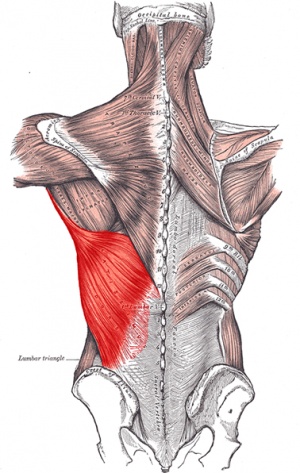Latissimus Dorsi Muscle: Difference between revisions
Ahmed Nassef (talk | contribs) No edit summary |
No edit summary |
||
| Line 68: | Line 68: | ||
The lateral aspect of the latissimus dorsi muscle builds the posterior border of the axilla. It is felt to contract during resisted adduction of the arm. Its insertion lies anteriorly at the crest of the lesser tuberosity. | The lateral aspect of the latissimus dorsi muscle builds the posterior border of the axilla. It is felt to contract during resisted adduction of the arm. Its insertion lies anteriorly at the crest of the lesser tuberosity. | ||
== Latissimus Dorsi Stretches == | == Latissimus Dorsi Stretches == | ||
Begin this latissimus dorsi stretch standing tall with your back straight and hands above your head. Gently lean to one side until you feel a mild to moderate stretch in the side of your upper back and shoulder (figure 2). Hold for 5 seconds and then return to the starting position. Repeat 10 times provided the exercise is pain free. Then repeat the exercise on the opposite side. | Begin this latissimus dorsi stretch standing tall with your back straight and hands above your head. Gently lean to one side until you feel a mild to moderate stretch in the side of your upper back and shoulder (figure 2). Hold for 5 seconds and then return to the starting position. Repeat 10 times provided the exercise is pain free. Then repeat the exercise on the opposite side. | ||
{| width="100%" cellspacing="1" cellpadding="1" | |||
|- | |||
| {{#ev:youtube|xcyOvJlOYeE|412}} | |||
| {{#ev:youtube|vZ0ddF4v3Pg|412}} | |||
|} | |||
= References = | = References = | ||
[[Category:Anatomy]] [[Category:Muscles]] | [[Category:Anatomy]] [[Category:Muscles]] | ||
Revision as of 12:58, 20 January 2018
Original Editor - Ahmed Nassef
Top Contributors - Lucinda hampton, Wanda van Niekerk, Ahmed Nassef, Kim Jackson, Uchechukwu Chukwuemeka, Joao Costa, Wendy Snyders, Admin and George Prudden
Description[edit | edit source]
The latissimus dorsi muscle, whose name means “broadest muscle of the back,” is one of the widest muscles in the human body. Also known as the “lat,” it is a very thin triangular muscle that is not used strenuously in common daily activities but is an important muscle in many exercises such as pull-ups, chin-ups, lat pulldowns, and swimming.[1]
Origin[edit | edit source]
a. Spinous processes of T7 - L5 vertebrae.
b. Iliac crest of sacrum.
c. Thoracolumbar fascia.
d. Inferior angle of the scapula.
e. Lower three or four ribs.[2]
Insertion[edit | edit source]
Floor of intertubercular (bicipital) groove of humerus.[2]
Nerve supply[edit | edit source]
Thoracodorsal nerve (C6 – C8)[3]
Blood supply[edit | edit source]
Thoracordosal Artery from the axillary artery[3]
Action[edit | edit source]
Depression, adducts, extends and internally rotates the arm at the shoulder[3]
Primary Actions of the Latissimus Dorsi
1. Adduction of the arm at shoulder
- Agonists: Pectoralis Major, Teres Major, Triceps Brachii (long head)
- Antagonists: Deltoid (middle) Supraspinatus
2. Extension of the arm at the shoulder
- Angonists: Deltoid (posterior) Triceps brachii (long head), pectoralis major (sternal head)
- Antagonists: Deltoid (anterior) Biceps brachii, Coracobrachialis, Pectorial Major (clavicular head)
3. Internal rotation of the arm at the shoulder
- Agonists: Subscapularis, Deltoid (anterior), Pectoralis Major, Teres Major
- Antagonists: Infraspinatus, Teres minor, Deltoid (posterior)
Secondary Actions of the Latissimus Dorsi
1. Assists with extension of the trunk
- Agonists: Longissimus thoracis, Iliocostalis lumborum, Iliocostalis thoracis
- Antagonists: Rectus abdominis
2. Assists with flexion of the trunk
- Agonist: Rectus abdominis
- Antagonists: Longissimus thoracis, Iliocostalis lumborum, Iliocostalis thoracis
3. Assists with lateral flexion of the trunk
- Agonist: Quadratus lumborum, Rectus abdominis
- Antagonists: Longissimus thoracis, Iliocostalis lumborum, Iliocostalis thoracis
4. Assists with anterior and lateral pelvic tilt
- Agonist: Rectus abdominis
- Antagonists: Semitendinosus, Semimembranosus, Biceps femoris
5. Assists with depression of the scapula
- Agonists: Serratus Anterior (lower fibers), Trapezius (lower fibers), Pectoralis minor
- Antagonists: Levator Scapulae, Trapezius (upper fibers)
6. Assist with protraction of the scapula
7. Assists with deep inspiration and forced expiration [4]
Palpation[edit | edit source]
The lateral aspect of the latissimus dorsi muscle builds the posterior border of the axilla. It is felt to contract during resisted adduction of the arm. Its insertion lies anteriorly at the crest of the lesser tuberosity.
Latissimus Dorsi Stretches[edit | edit source]
Begin this latissimus dorsi stretch standing tall with your back straight and hands above your head. Gently lean to one side until you feel a mild to moderate stretch in the side of your upper back and shoulder (figure 2). Hold for 5 seconds and then return to the starting position. Repeat 10 times provided the exercise is pain free. Then repeat the exercise on the opposite side.
References[edit | edit source]
- ↑ Ahlke Heydemann, Severe murine limb-girdle muscular dystrophy type 2C pathology is diminished by FTY720 treatment, Muscle & Nerve, 3, 56, , 2007 486-494
- ↑ 2.0 2.1 Drake R L, Vogl AW, Mitchell A W: Gray's Anatomy for Students, ed 2, 2009, Churchill Livingstone.
- ↑ 3.0 3.1 3.2 Calais-German, Blandine. Anatomy of Movement. Seattle: Eastland Press, 1993. Print
- ↑ Schünke, Michael., Schulte, Erik, and Schumacher, Udo. Prometheus: Lernatlas der Anatomie. Stuttgart/New York: Georg Thieme Verlag, 2007. Print







